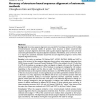1059 search results - page 20 / 212 » Discovering Sequence Similarity by the Algorithmic Significa... |
BMCBI
2007
13 years 8 months ago
2007
Background: Accurate sequence alignments are essential for homology searches and for building three-dimensional structural models of proteins. Since structure is better conserved ...
BMCBI
2008
13 years 8 months ago
2008
Background: In DNA microarray experiments, discovering groups of genes that share similar transcriptional characteristics is instrumental in functional annotation, tissue classifi...
ISWC
2006
IEEE
14 years 2 months ago
2006
IEEE
We present an approach to activity discovery, the unsupervised identification and modeling of human actions embedded in a larger sensor stream. Activity discovery can be seen as ...
BMCBI
2002
13 years 8 months ago
2002
Background: Expressed sequence tags (ESTs) are single pass reads from randomly selected cDNA clones. They provide a highly cost-effective method to access and identify expressed g...
BMCBI
2004
13 years 8 months ago
2004
Background: In addition to known protein-coding genes, large amounts of apparently non-coding sequence are conserved between the human and mouse genomes. It seems reasonable to as...

